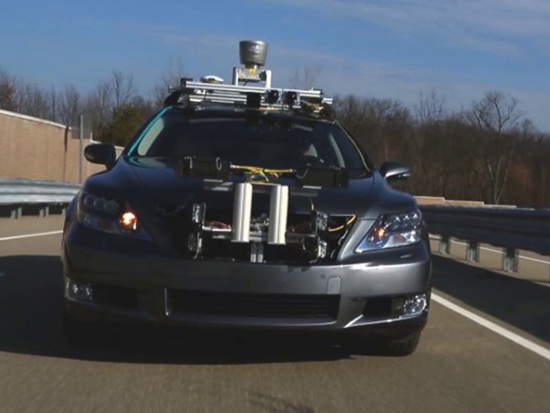Toyota revealed a modified Lexus LS 600 at CES to showcase the autonomous technology it is working on. Image via Ian Sherr/The Wall Street Journal
Having given tantalising glimpses of the autonomous vehicle technology it has been pioneering in recent times, yesterday Toyota announced details of the technology that could pave the way for a self-driving car in the future.
Mark Templin, group vice-president at Lexus, took to the stage at CES yesterday to announce details of how Lexus and Toyota are researching automated integrated active-safety technologies of the future.
Templin kicked off by saying the goal is to eliminate future traffic fatalities and injuries. He spoke about how the 2013 Lexus LS car, launched last October, features what he called “the world’s most advanced active-safety pre-crash system”, with millimeter-wave radar, a stereo camera and near infra-red projectors.
He then offered a glimpse of Toyota’s advanced active safety research vehicle, a modified Lexus LS 600 hybrid, which was on display.
The car’s features include high-definition colour cameras, advanced GPS functions, forward and side-facing radar, 360-degree laser tracking and sensor components, such as gyroscopes and accelerometers.
Templin said the goal is to pioneer a system that can constantly perceive, process and respond to its surroundings; that can scan the movement of objects around it; distinguish a green light from a red light; and accelerate and brake along the most efficient route.

Lexus AASRV, a retrofitted Lexus LS 600h that features autonomous driving technologies
Driverless car?
And while many people might equate the term ‘autonomous’ with ‘driverless’, he said that is only part of the story.
“Instead, we believe that in our pursuit of developing more advanced automated technologies the driver must be fully engaged in the operation of the vehicle at all times.
“Our vision is not necessarily a car that drives itself but rather a car equipped with an intelligent, always-attentive co-pilot whose skills contribute to safer driving,” said Templin.
He added that automated technologies should make driving easier and simpler, enhancing a driver’s perception of his or her environment and overall safety skills.
R&D
Toyota has been testing its autonomous technologies at its proving ground at the Higashi-Fuji Technical Center in Japan over the past few months. Templin said the facility simulates an urban environment that links road-to-vehicle, vehicle-to-vehicle, pedestrian-to-vehicle and traffic signals.
“The research conducted at our proving grounds will help prevent accidents involving pedestrians and other vehicles, improve poor visibility at intersections,” he said.
Templin also said Toyota would be looking to collaborate with government regulators to help advance future mobility.
The auto giant is also carrying out pure research at its institute in Ann Arbor, Michigan, including on the Lexus LS hybrid that was on display at CES yesterday.
Templin said the company could not speculate on how or when such a car would be available in the marketplace.
“At the moment, this is a pure research project with a strong statement of the shape of things to come,” he said.
Main image credit: Ian Sherr/The Wall Street Journal